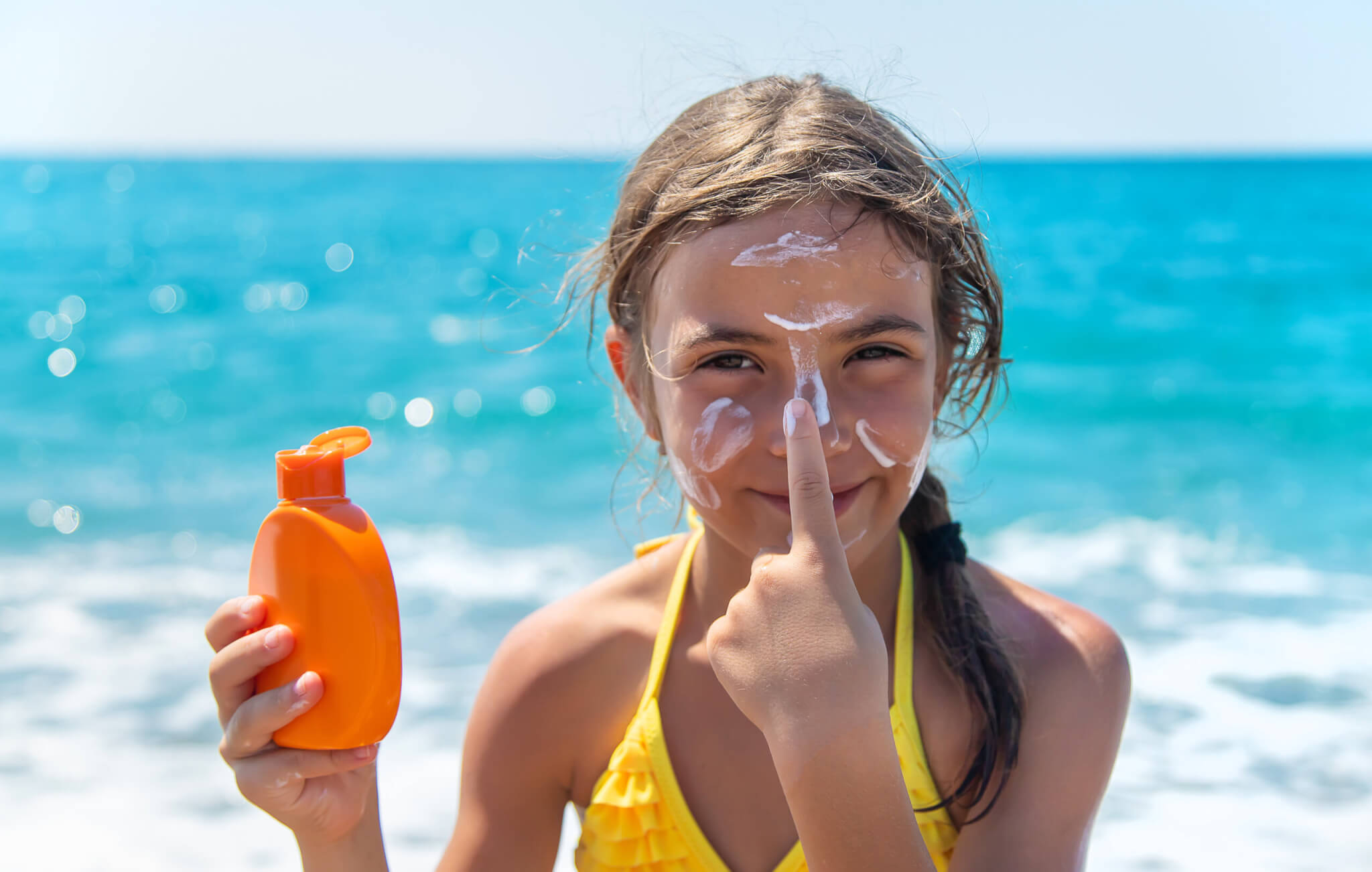Sun protection should be an essential part of everyone’s skincare routine, and that starts in childhood. According to Dr. Alexandra Theriault of U.S. Dermatology Partners Denver, “Establishing good sun protection habits early has a lasting impact on a young person’s skin health. Not only does it minimize risk for serious skin health issues like skin cancer, but effective suncare routines also keep skin healthy and beautiful.” In this blog, Dr. Theriault provides top sunscreen and sun safety tips for kids and teens.
Understanding the Importance of Sunscreen for Young Skin
Daily sunscreen application is beneficial at every age, but sun damage is cumulative, which means the earlier you protect your skin, the better. According to Dr. Theriault, “Just one sunburn dramatically increases risk for developing skin cancer, including melanoma, later in life. Skin damage accumulates from the child’s very first exposure to the sun. The more often individuals develop sunburns, the more likely they are to experience long-term negative effects of sun exposure like skin cancer and accelerated signs of aging. Even though the long-term effects of sun damage can be bad, the immediate sunburn damage is also painful for young people, and severe sunburns can lead to infection or scarring.”
Choosing the Best Sunscreen for Kids
It’s important to find a sunscreen that is both safe and effective to protect children’s skin from sun damage. Some of the most important factors to consider when choosing the best sunscreen for kids and teens include:
- Sun protection factor (SPF) – an SPF of 30 to 50 is recommended.
- Broad-spectrum – this means that sunscreen protects against both UVA and UVB rays.
- Water-resistance – if kids are going to be in water or sweating, it’s important to find a sunscreen that is water-resistant. No sunblock is completely waterproof, but many of those marketed as water-resistant significantly improve the longevity of sun protection.
- Mineral sunscreen – chemical sunscreens use ingredients like oxybenzone that can be harmful, especially for children. Mineral sunblock uses zinc or titanium dioxide to protect skin. It’s safe for children of all ages and for use on sensitive skin.
Tips for Proper Sunscreen Application
In addition to choosing the right sunscreen, it’s important to apply sunblock correctly. Below, Dr. Theriault outlines the basics for proper sunscreen application.
- Use enough sunscreen to cover any parts of the body that are exposed to sunlight, including the face, neck, and hands, every day. Other parts of the body that are exposed when wearing shorts, swimsuits or flip flops should also be covered. The amount of sunscreen necessary for coverage varies, but most children are covered by an ounce or two of sunblock.
- Apply sunscreen at least 15 minutes before leaving the house. This gives the product plenty of time to absorb and dry, so it won’t rub away or be sweated off quickly.
- If your child is old enough to apply sunscreen, guide them through the process and double check their work to ensure complete coverage. For young children, make sure applying sunscreen is a fun and normal part of their day, so they are less likely to fight the process.
- Reapply sunscreen at two-hour intervals. If kids are swimming or sweating, more frequent reapplication may be necessary.
Additional Sun Protection Measures
Sunscreen goes a long way, but there are other sun protection measures that keep kids and teens safe in the sun. Some of the recommended sunscreen tips for teens and children include:
- Block sun completely from infants under 6 months old. Use umbrellas or other covers to shield them from direct sun exposure.
- Dress children in rash guards and other protective clothing when in the water or outdoors for long periods.
- Have kids wear hats to provide added protection for the face, neck, and eyes.
- Sunglasses make it easier for young people to see outdoors when it’s sunny, and they also protect the eyes from potential sun damage.
- Seek shade periodically when outdoors for long periods to give the skin a chance to rest and recover. This is also a good opportunity to reapply sunscreen.
- Limit time outdoors during peak sun hours between 10 am and 4 pm.
Common Sunscreen Mistakes to Avoid
When applying sunscreen with children, Dr. Theriault says, “On days when the sun is out and it’s warm, it’s easy to remember the importance of applying sunscreen. On cold or cloudy days, it’s easy for parents to deprioritize suncare with everything else going on. However, even when it’s cloudy, rainy, or snowing, sun damage can still occur. In addition to skipping sunscreen when it’s not sunny out, another common mistake is applying an inadequate amount of sunscreen to protect all exposed areas. In some situations, less is more, but not with sunscreen. Make sure coverage is complete over all areas. If you need to apply a second coat just to be safe, do it! It’s also important to cover all skin exposed to the sun. Many people don’t think of places like the exposed scalp at the hairline and the ears. These often-forgotten spots can be easily burned by the sun.”
Encouraging Good Sun Protection Habits
When it comes to encouraging good sun protection habits, Dr. Theriault says, “You know your child. Appeal to their interests and desires. If you have a young child who loves playing games, make sunscreen application a game. If you have an adolescent who’s worried about their appearance, make sure they understand the repercussions of poor sun protection habits. Include them when choosing sunscreens, knowing that tinted options can be a great alternative to make up and is more cosmetically elegant on those with darker skin tone.” Some general tips for encouraging good sun protection habits include:
- Make sunscreen part of your child’s life from the start. Apply sunscreen when they are infants and toddlers. As soon as they are old enough, have them begin helping or applying sunscreen on their own.
- Give your child ample time to get ready and apply sunscreen. If applying sunscreen is always the one thing preventing your child from going out to play, they may start to dread applying sunblock or try to skip it to get outside faster. For teens, having ample time to appropriately apply sunscreen as part of their cosmetic and skincare routine may be important for them.
- Make sunscreen part of your child or teen’s daily skincare routine. Applying sunblock every day is beneficial for short and long-term skin protection. It also makes applying sunscreen a normal part of the child or teen’s day-to-day life, so when they’re outdoors for a long period of time, it’s second nature to ensure they’re applying and reapplying sunscreen.
- Talk honestly with children and teens about the importance of protecting skin from the sun’s damaging rays. Gear your conversations toward the age of the young person. You don’t want to scare younger children, but you should tell them sunblock keeps skin healthy and safe. For teens, appeal to their vanity by letting them know that sun exposure can lead to accelerated signs of aging like fine lines and wrinkles.
- Model good behavior. If you apply sunscreen daily and reapply often when you’re spending time outdoors, your child is more likely to mimic this behavior.
- Make sunscreen fun. This one is geared toward younger children. A fun way to teach them about peak sun exposure times in the day is to help them recognize when the sun is most dangerous. Teach them that their shadows will tell them when the sun is strongest. Long shadows mean the sun’s rays aren’t very strong. Short shadows mean the sun is at its highest intensity. You may be surprised to hear your child asks for sunscreen when they notice their shadows getting shorter.
Don’t Let Sun Damage Now Lead to Skin Health Concerns Later
According to Dr. Theriault, “The effects of sun damage on skin are cumulative. For this reason, it’s important to start protecting skin from UVA and UVB rays as early as possible. That means instilling good sun protection habits in our children at the earliest possible stages. Make sun protection a fun part of the routine for adventures outdoors in childhood. Make sure teens understand how important sunscreen is to keep skin looking great. Generally, do whatever you can to make applying sunblock something your child wants to do.”
Consult a Dermatologist for Personalized Sun Protection Recommendations
Early sun protection can be the difference between your child or teen growing up with healthy skin or having an elevated risk for skin cancer and other concerns. Finding the best sunscreen for your child and applying and reapplying it properly is much easier with the knowledge and support of a dermatologist. If you’re interested in learning more about sunscreen for your child or other skincare tips and needs for young people, don’t hesitate to reach out to schedule an appointment at U.S. Dermatology Partners by completing our online scheduling request form. Once we receive your request, a member of our team will be in touch to finalize the details of your upcoming appointment.
Find a location near me
or


